Screen To Stage: Films That Would Make Impressive Plays

Rachael Sampson is a Yorkshire screenwriter and film critic. She…
William Shakespeare, Arthur Miller, Oscar Wilde, Samuel Beckett and Harold Pinter; when it comes to playwrights who have had their work go from stage to silver screen, the list sees no end. Whilst everyone cannot resist a new portrayal of a timeless piece of literature incorporated with modern twists and/or special effects, audiences are constantly being introduced to plays through the expression of cinema. While this is a positive notion, it does however highlight the contrary: why is the transition from stage to screen not reciprocated?
In light of this difference, here are a selection of films which could be adapted to make riveting and enjoyable pieces of theatre, allowing admirers of film to witness the content through a different artistic style. Bringing stories from the big screen to the stage will enable audiences to see action and conflicts they know and love come to life in the third dimension (without having to wear the glasses).
The Hateful Eight (2015)
Tarantino‘s latest exploit about eight suspicious characters who take shelter from a blizzard at first glance irrefutably holds strong parallels with a piece of theatre in relation to the murder mystery angle and the intimate setting of Minnie’s Haberdashery. It resembles other theatrical productions in the past, such as J.B. Priestley‘s An Inspector Calls, which was also adapted for the screen in 1954 (An Inspector Calls). Before Tarantino considered making this film, he initially wrote it for the stage, and the director has disclosed plans to stage The Hateful Eight after his 10th movie – something audiences are highly anticipating.
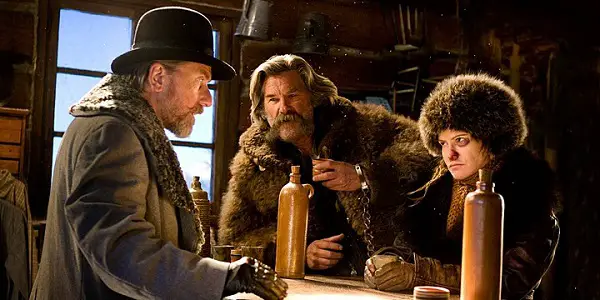
What makes this tale such a good play story is the simple fact that everyone is a suspect. Films are often guilty of revealing a bias when it comes to characters, and they will state quite clearly and early on in the movie who the protagonist is, and this can be shown through camera angles and the obvious followings of specific characters, (something even playwrights are guilty of); however that is unidentifiable within this story. Yes, the viewer is only exposed to selective characters making the journey to Minnie’s Haberdashery, but with all the characters being on a similar level, (and in this case, a hateful one), it marks the eight ‘antagonists’ questionable, for they all hold a level of disrepute.
The simplistic setting predominantly being in one location revokes all the unnecessary changes of scene, and keeps the issue and root of the attention drawn to the stage. The film’s main themes are deceit, suspicion and violence, and these are drawn out of the performance in the most gritty and raw ways possible, without the inessential hindrance of special effects. The Hateful Eight allows audiences to become the 9th character, so to speak, as they take on the role of inspector, trying to identify who isn’t exactly who they say they are.
At first, Tarantino had the idea of writing a series of paperback novels about Django and Shultz’s adventures from his previous movie Django Unchained (2012), and he was to name these paperbacks Django in White Hell. However, he realised that combining the genre of murder mystery with a moral centre would not work, so out went Django and in came the eight adversaries. If The Hateful Eight was to become a play, Tarantino‘s dialogue alone would make it a fantastical experience; but combined with the setting, indistinguishable protagonists, questionable motives and knife-cutting tension shown in his 8th exploit, who wouldn’t want to witness this story unfold right in front of their very eyes?
Bronson (2008)
Nicolas Winding Refn’s 2008 adaptation of profile of Tom Hardy, the motion picture alternates between theatrical and cinematic formats. This biopic, based on the autobiography of Britain’s most violent prisoner, explores his life in an artistic and expressionistic way. Due to Charles Bronson himself being somewhat of an artists’ poet and writer, Refn‘s film pays homage to his heart-breaking story from an artistic angle. Bronson is trapped and isolated, which subsequently plays with his mind. Therefore, his thoughts translate into art forms, and with theatre being its own art, seeing Bronson on the stage would allow for the caged mind of a ‘mad man’ to be set free. It is a terrifying, yet exciting notion.
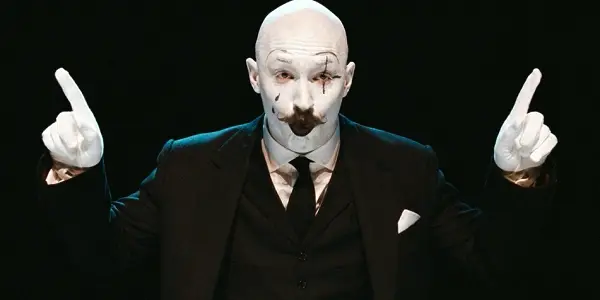
Bronson is seen in a variety of different states throughout this film, and one could find comparisons between his theatrical speeches and Shakespeare’s famous soliloquies; Bronson breaks the 4th wall, directly looks into the camera and also addresses the audience, who feature in the film. Admitting certain truths about prison, life or lack thereof, gives the movie somewhat of a tragic Macbeth/Hamlet feel.
It is almost as if the theatrical, over-the-top versions of Bronson are in fact the most real and truthful reflections of him as a man. To hear these admittances out loud in the theatre might enforce that even more, and the juxtaposition of combining over-the-top acting with sensitive confessions in the real, intended location of the film strips down that cinematic barrier. Seeing this film in a live setting would almost enable individuals to connect on an even more intimate level with one of the most isolated, unreachable and lonely men trapped in the prison system.
A theatre space has the ability to create an environment for the audience to feel unified/alone/vulnerable/comfortable etc., and in this case it could be manipulated to emit the feeling and sensation of entrapment. This can be done by rearranging the seating, or having the setting of the piece in an unorthodox location. As the film is predominantly set in a prison, feelings of confinement and claustrophobia can be created in the audience area to make them have a deeper understanding of his lifestyle, thus making the audience feel like another group of inmates at “Broadmoor Asylum for the Criminally Insane”.
As quoted in the film, Hardy‘s Bronson states:
“My name is Charles Bronson, and all my life I’ve wanted to be famous. I knew I was made for better things. I had a calling. I just didn’t know what as.”
Bronson‘s thirst for fame is shown throughout the film and some of the costumes and characters he manifests into in the movie are of stereotypical 20th century theatre; e.g. the hermaphrodite Josephine Joseph-esque character that features in the movie Freaks (1932), and the white face paint, gloves and black suit combination to impersonate a French mime artist. Another mentionable feature of the film is that one of the settings is actually the theatre itself; therefore it seems almost unavoidable to have this tale be portrayed on the stage, and see Charles Bronson‘s story go from book to film to play.
Trainspotting (1996)
The black comedy Trainspotting directed by Danny Boyle was a cinematic sensation in the ’90s and still lives to be one of the highest grossing British films of all time. The film surrounds a group of heroin addicts from the 1980s living in the economically depressed area of Edinburgh, and the movie shines a light on drug addiction and urban poverty through a ruthless revealing of working class Britain. The subject matter alone would make the film intriguing to stage, and in addition, it would act as informative to those who do not have much knowledge about it; therefore these people could potentially be reached through a theatrical rendition of Boyle’s classic hit.
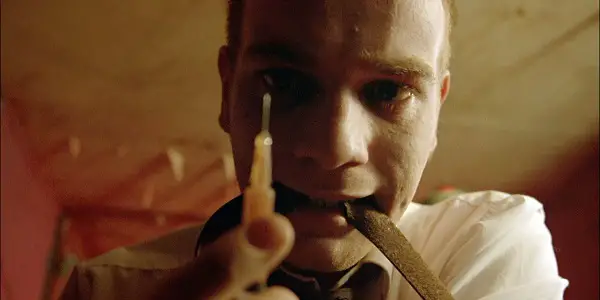
There is one very prominent scene in the movie where the protagonist, Mark Renton (Ewan McGregor) takes an overdose of heroin and the audience sees him falling into the floor and sinking away in a state of paralysis accompanied by Lou Reed‘s Perfect Day. This scene is tragic yet comedic, as he is dragged into a taxi and calmly sent to hospital, as it wasn’t considered out of the ordinary for people to fall into the narcotic culture of the ’80s. The film has a surrealist tone to it throughout, as audiences also see Renton sink into ‘the worst toilet in Scotland’, which is disgustingly derelict. Since Trainspotting takes audiences on a drug trip themselves, it would be very interesting to stage, as the theatrical space could be transformed into another world, engulfing the audience into a state of psychedelia.
People have often criticised Trainspotting for a belief that it ‘glamorises’ drugs, and whilst the scenes of surrealism and out-of-body experiences look pleasurable and exciting, there still remains a great deal of tragedy in the film. Having a live interpretation of the loss of beloved characters, and death of innocence when Allison’s baby is found dead from neglect due to her drug addiction, the piece would become grounded and hit people hard. It is difficult to watch on the screen, but having Allison’s screaming and crying stare audience members directly in the face, individuals will be able to interpret for themselves if it was all worth it on a larger scale. It will drag the surrealist euphoria down to earth.
The advantage of adapting a screenplay into a play means it is flexible – the story can be played with. Since a large group of people support the belief that Boyle‘s Trainspotting advocated drug addiction, then the play could be adapted to take a darker route, and explore the story from a more factual angle, showing the true damage and destruction that drugs can cause.
The Addams Family (1991)
Director Barry Sonnenfeld brings Charles Addams’ cartoon sketches to life in this offbeat fantasy/comedy film. The Addams’ are a satirical inversion of the ideal American family: an eccentric wealthy clan who delight in the macabre and are unaware/do not care that other people find them strange or frightening. The film’s main plot is centered around a loan shark wanting to get the Addams’ fortune, and notices that her son looks like Fester Addams, (Gomez Addams’ brother who has been missing for years) so she forces her son to pose as ‘Uncle Fester’ to try to get into the vault and take their riches. Although it seems quite dark and deceitful, it is rather the contrary, as family and unity is at the heart of this quirky film. Set in the gothic mansion of the family, a staged production would revive a ’90s classic, rendering it in a light-hearted, Upstairs, Downstairs fashion.
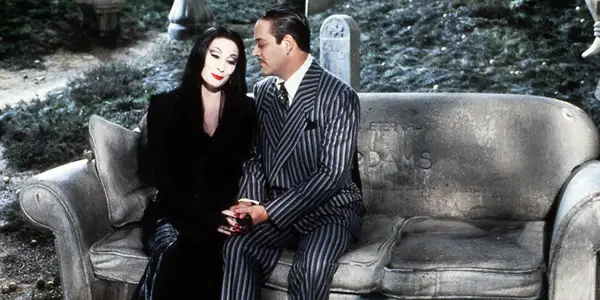
The vacant responses and bizarre statements these characters give almost warrant that over-layered phony laugh and applause many sitcoms include in their pictures, except with a live audience it will be physically received. The added factor will be of watching actors hold a strict gaze during a live performance when saying lines such as:
Morticia: Children, what are you doing?
Wednesday: I’m going to electrocute him.
Morticia: But we’re late for the charity auction.
Wednesday: But, Mother…
Morticia: I said no.
Pugsley: Pleeaaaase?
Morticia: Oh, all right.
This adds another element of comedy to the piece; seeing the actors keep focused and fixated on their role when the audience breaks into laughter is something that can only be experienced theatrically. As the film is lighthearted and family oriented (rated PG), there are moments when it can be envisaged as pantomime-esqué, and where audience participation would be fitting, especially in the scene where Gomez has a feeling that Fester isn’t actually Fester. In these instants, children would intrinsically want to react and say the typical “oh no he isn’t/yes he is” gimmick.
The set and costume design cannot go ignored when considering this film’s potential to be staged, as the whole gothic castle setting within a theatre space would be a remarkable and aesthetically pleasing environment, especially if this play was performed around Halloween. The costumes and makeup seen in the film are very comparable with famous theatrical looks in the past, guilty of combining the world of The Rocky Horror Picture Show with monochrome. In fact, the entire film is basically an aesthetical version of Rocky Horror, and when looking at that film’s popularity (ratings and profit in terms of theatre), there is no doubt that a theatrical version of The Addams Family will also be well received.
The Breakfast Club (1985)
This John Hughes classic explores 5 high school students who meet in detention, and during their punishment they discover that they have a lot more in common than they thought. Set in a high school on a Saturday morning, these rebellious teens find common ground in their differences. Hughes plays on the classic teenage stereotypes (the princess, the athlete, the criminal, the basket case and the brain) and with five to choose from, audiences instantly see certain aspects of themselves in each character, either representing them as teenagers now, or the teenagers they used to be.
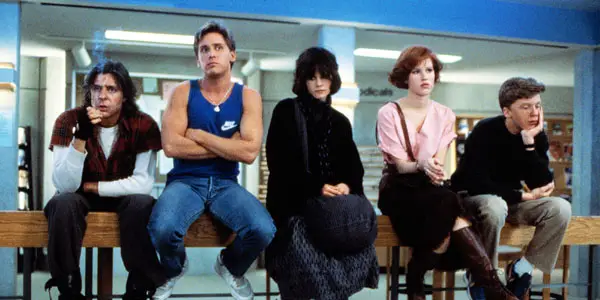
This cult classic reads like a play with its emotive character development and tear-jerking confessions told by each student. Exploring topics such as sex, social status, drug use, parental frustration and even suicide, it paints an interesting portrait of issues every teenager faces/thinks about. This film would be quite simple yet effective to stage, for the location is single and the story flows without the need for drastic and complex editing or scene changes.
If The Breakfast Club was to be performed in front of a live audience, it gives the opportunity for the audience to see the reactions from all of the cast throughout the piece, as camera angles and up-close shots in the filmic version restrict said viewing. An example of this is when John Bender pushes Principle Richard Vernon’s buttons and gets a string of 8 more detentions. This intense scene tosses back and forth between the two actors with closeup shots, and whilst this is rather potent, it could be intensified further by featuring the rest of the cast’s glances of horror as Bender slowly pushes his freedom away. This is also apparent for the pivotal ‘confessions’ scene, as the audience would be able to see how each disclosure affects all of the characters, not just a selective few in sporadic bursts. If The Breakfast Club was to be portrayed in this manner, the characters would have nowhere to hide, thus depicting the narrative as an intensified and unconcealed interpretation.
This classic teenage movie would benefit from being revived on the stage because it could be renewed and adapted to fit the 21st century. The use of technology (phones, laptops, etc.) could be incorporated to show these characters in today’s brainwashed society, alongside dressing them in the latest teenage trends. As The Breakfast Club was filmed 31 years ago, a lot has changed since then, and it would be nice to see Claire Standish absorbed into her phone, texting and tweeting, and Brian Johnson talk about technology as if he was the new Steve Jobs.
Incorporating these modernised features would also make the piece even more audience reflective, as today’s generation would be able to relate more strongly to the characters if they lived in the era of advanced technology. Many might say this could be done with another remake of the film, and whilst that is true, remaking such a classic film might not digest well with fans of the 1985 original, as nobody could fill the late John Hughes‘ directorial boots.
Overall
It is evident that there are a variety of films which would make fantastical pieces of theatre, either in relation to the setting, dialogue, characters, or simply because the story is so admirable. Here are a selection of other notable works which would also be engaging, interesting and plausible theatrical adaptations: John Waters‘ Cry-Baby (1990), Quentin Tarantino‘s Four Rooms (1995), David O. Russell‘s Silver Linings Playbook (2012) and Joel Schumacher‘s A Time to Kill (1996).
In terms of screening plays, it is a very wide one-way street, and because of the constant regurgitation of play adaptations for the big screen, it is time the process was reversed. It has been said that “the theatre is a dying art form“, and whilst many may agree with this, it should therefore be resuscitated, and a way this can be done is performing well admired movies through this platform.
The main reason people get into the artistic industry of theatre, film and television is because they have a strong passion and love for telling stories. Storytelling is at the heart of most, if not all art forms, and they should be shared and retold in as many ways as possible. Therefore, by combining the world of cinema with theatre in both directions, something new and exciting will be hatched out of a classic and well-loved narrative paradigm.
Which films would you like to see come to life in the theatre? Please share your thoughts and comments!
Does content like this matter to you?
Become a Member and support film journalism. Unlock access to all of Film Inquiry`s great articles. Join a community of like-minded readers who are passionate about cinema - get access to our private members Network, give back to independent filmmakers, and more.
Rachael Sampson is a Yorkshire screenwriter and film critic. She often finds herself daydreaming about Andrea Arnold's filmography or crying over The Graduate.













